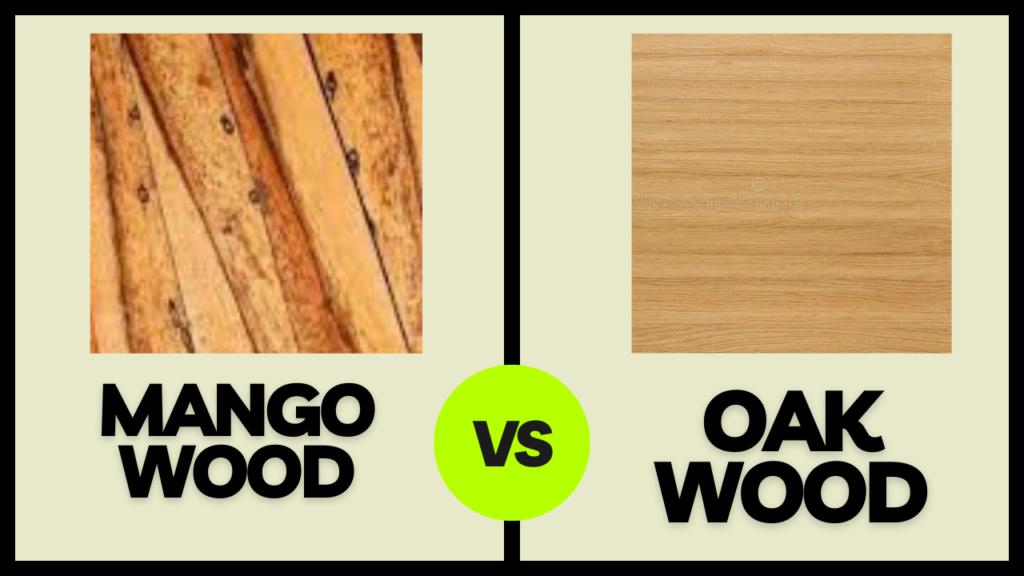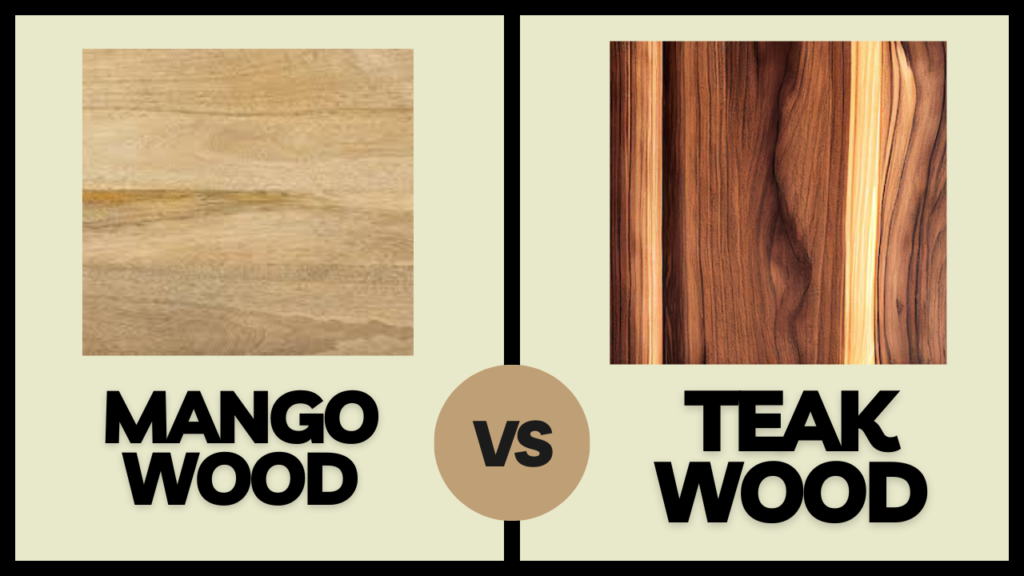Mango Wood
Mango wood is gaining popularity for making furniture and other woodworking projects because it’s both sustainable and attractive. It comes from the mango tree (Mangifera indica), known for its fruit. This hardwood is valued for its beauty, strength, and eco-friendly qualities. Let’s take a closer look at what makes mango wood special, its benefits, and how it’s used.
Characteristics
Appearance and Color
Mango wood is loved for its attractive appearance and many different colors. It can be golden brown to light brown with patterns of yellow, pink, or black. These colors come from spalting, where fungi make interesting designs on the wood.
As this wood gets older, it gets a deeper color called a patina. This makes it even more beautiful. Each piece of this wood becomes unique and special as it ages.
Grain and Texture
The grain of mango wood can be straight or interlocked, with a medium to coarse texture. This special grain pattern adds to its attractiveness and makes every piece of this wood furniture unique. This wood also has a nice natural shine that becomes even better when it’s polished or finished.
Density and Hardness
It is considered a hardwood because it has a dense grain structure. It has a Janka hardness rating of 1,070 lbf (4,780 N), similar to North American hardwoods like oak. This density makes it strong and durable, making it a great option for furniture and other uses where sturdy materials are needed.
Benefits
Sustainability and Eco-Friendliness
Mango wood is sustainable because mango trees are grown mainly for their fruit, and the wood is only harvested after the tree stops producing fruit. This means trees aren’t cut down just for wood, making this wood a good choice for the environment. Mango trees grow fast, usually maturing in about 15 years, much quicker than oak, which can take up to 75 years. This fast growth helps keep mango wood sustainable and ensures there’s always enough available.
Durability and Strength
Even though mango wood is softer than some hardwoods, it’s still strong and lasts a long time. Its dense grain makes it tough and resistant to wear and tear, so furniture and other things made from these wood can handle daily use. With the right care, it’s furniture can stay in good shape for generations, making it a smart investment.
Water Resistance
These woods are great in resisting water, which makes it good for outdoor furniture and places where there’s a lot of moisture. But it’s important to take care of it regularly because too much water over time can still cause damage.
Workability
Carpenters and woodworkers like using mango wood because it’s easy to work with. It can be cut, shaped, and carved easily, so it’s good for lots of different projects. This wood also behaves well to polishing, waxing, and staining, so you can create many different looks and styles with it.
What is mango tree wood used for?
Furniture: Mango wood is widely used for making furniture like chairs, tables, cabinets, dressers, and bed frames because it’s durable and looks good.
Musical Instruments: It’s used to make some musical instruments, particularly ukuleles.
Flooring and Wall Paneling: These woods are good for flooring and decorative wall panels because it lasts a long time and looks nice.
Kitchen Accessories: Items like cutting boards and utensils are often made from it due to its water-resistant properties.
Decorative Objects: It is used to make picture frames, bowls, and sculptures.
Veneer and Plywood: The wood is utilized in the production of veneer and plywood.
Turned Objects: Its workability makes it good for turned objects.
Outdoor Furniture: Due to its water-resistant qualities, mango wood can be used for outdoor furniture, though proper sealing and maintenance are crucial.
Doors: These woods are sometimes used in door production.
Construction Material: In some cases, it’s used as a general construction material.
Why is mango wood cheap?
Sustainability and Abundance:
Mango wood comes from mango trees that are harvested after they stop producing fruit, usually after 15-20 years. This cycle of planting and harvesting makes it sustainable.
Mango trees grow fast, reaching maturity in about 15 years, much quicker than hardwoods like oak that can take up to 75 years. They’re plentiful in tropical areas across Asia, the Pacific, and parts of South America, ensuring a steady supply.
Low Processing Costs:
Processing these wood’s is simple and doesn’t cost much. It’s softer than other hardwoods, so making furniture from it is quicker and cheaper.
Dual-Purpose Trees:
Mango farmers focus on growing fruit, so the wood is a bonus product they sell at lower prices, still making money from their main crop.
Local Production:
Local artisans often make mango wood furniture in the same places where the trees grow. Lower labor costs in these countries mean the finished furniture is more affordable.
Market Factors:
Historically, there has been less demand for mango wood compared to more traditional furniture woods like oak or mahogany. This lower demand has kept prices competitive.
Versatility:
These wood hasn’t been as popular as oak or mahogany, so it’s priced competitively. It takes stains and finishes well, so it can look like more expensive woods for a lower cost.
They are affordable because it’s sustainable, easy to process, grown alongside fruit crops, made locally, and priced competitively due to market factors.
Is mango wood better than oak?

When comparing mango wood and oak, both have their advantages and disadvantages. Here’s how they stack up:
Mango Wood:
Pros:
- More affordable than oak
- Harvested sustainably from fruit trees past their productive years
- Unique grain patterns and colors
- Fairly durable for its price
Cons:
- Less durable than oak
- Can dry out and crack in dry conditions
- More prone to fungal and insect attacks if not treated
- Some people may experience skin irritation
Oak:
Pros:
- Extremely durable and long-lasting
- Classic, timeless appearance
- Very strong (higher on Janka hardness scale than mango)
- Resistant to wear and tear
Cons:
- More expensive than mango wood
- Heavier than mango wood
- Doesn’t resist water well without treatment
Is mango wood the same as teak?

Mango wood and teak are different types of wood with unique characteristics:
Origin and Species:
- Mango wood comes from the mango tree (Mangifera indica).
- Teak wood comes from the teak tree (Tectona grandis).
Durability and Strength:
- Teak is generally stronger and more durable than mango wood.
- On the Janka hardness scale, teak scores 2,330 while mango wood scores 1,070.
Water Resistance:
- Teak is naturally water-resistant due to its high oil content.
- Mango wood is less water-resistant and may need treatment for outdoor use.
Price:
- Mango wood is much cheaper than teak, about 10 times less expensive.
- Teak is considered a premium and expensive wood.
Sustainability:
- Mango wood is highly sustainable as it’s a byproduct of the fruit industry.
- Teak is less sustainable and has faced issues with overexploitation.
Growth Rate:
- Mango trees mature in about 15 years.
- Teak trees take 20-25 years to mature.
Appearance:
- Mango wood can have varied colors and unique grain patterns due to spalting.
- Teak has a more consistent golden to dark brown color with a straight grain pattern.
Maintenance:
- Mango wood requires more maintenance, especially in dry conditions.
- Teak needs less maintenance due to its natural oils and durability.
Is mango wood better than acacia wood?
Mango Wood vs Acacia Wood:
Durability:
- Acacia wood is generally tougher and harder than mango wood, making it more resistant to scratches and dents.
- Mango wood, being softer, is less durable especially for heavy-use furniture.
Water Resistance:
- Acacia wood naturally resists water better due to its dense grain structure.
- Mango wood has some water resistance but may need sealing for better durability.
Appearance:
- Acacia wood has a wider range of colors and more distinct grain patterns.
- Mango wood has warm, honey-colored tones with darker streaks running through it.
Sustainability:
- Mango wood is often seen as more sustainable since it comes from the fruit industry’s byproduct.
- The sustainability of acacia wood varies depending on the species and how it’s harvested.
Cost:
- Mango wood is generally more affordable compared to acacia wood.
Workability:
- Mango wood is easier to work with and shape compared to acacia wood.
Caring for Wood
To keep these wood items looking great for years, follow these care tips:
Regular Cleaning: Dust the wood often with a soft, lint-free cloth to keep dirt from building up.
Avoid Harsh Chemicals: Use mild soap or wood cleaners made for furniture. Harsh chemicals can harm the wood’s finish.
Protect from Moisture: Even though it resists water, wipe up spills right away. Use coasters or placemats to shield the surface.
Regular Polishing: Every few months, apply quality wood polish or wax to maintain its shine and prevent drying.
Avoid Direct Sunlight: Keep this wood furniture away from direct sunlight to avoid fading or warping. Use curtains to filter sunlight if needed.
Conclusion
Mango wood offers a compelling combination of beauty, durability, and sustainability, making it an excellent choice for furniture and various woodworking projects. Its unique appearance, strength, and eco-friendly nature have contributed to its growing popularity in recent years. By understanding its characteristics and proper care techniques, you can enjoy the beauty and functionality of mango wood items for many years to come.
Also read: Types of Mahogany Wood

